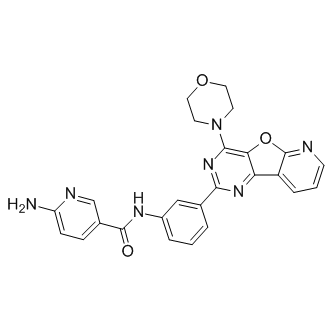| In Vitro: |
Acute treatment of cells with YM-201636 shows that the PIKfyve pathway is involved in the sorting of endosomal transport, with inhibition leading to the accumulation of a late endosomal compartment and blockade of retroviral exit. The yeast orthologue of PIKfyve, Fab1, is found to be insensitive to YM-201636 (IC50>5 μM). YM-201636 does not inhibit a type IIγ PtdInsP kinase even at 10 μM and inhibits a mouse type Iα PtdInsP kinase with an IC50>2 μM[1]. YM-201636 almost completely inhibits basal and insulin-activated 2-deoxyglucose uptake at doses as low as 160 nM, with IC50=54 nM for the net insulin response. YM-201636 also completely inhibits insulin-dependent activation of class IA PI 3-kinase[2]. At low doses (10-25 nM), YM-201636 inhibits preferentially PtdIns5P rather than PtdIns(3,5)P2 production, whereas at higher doses, the two products are similarly inhibited. YM-201636 at 160 nM inhibits PtdIns5P synthesis twice more effectively compared with PtdIns(3,5)P2 synthesis[3]. MDCK cells treated with YM-201636 accumulate the tight junction protein claudin-1 intracellularly. YM-201636 treatment blocks the continuous recycling of claudin-1/claudin-2 and delays epithelial barrier formation[4]. |






















